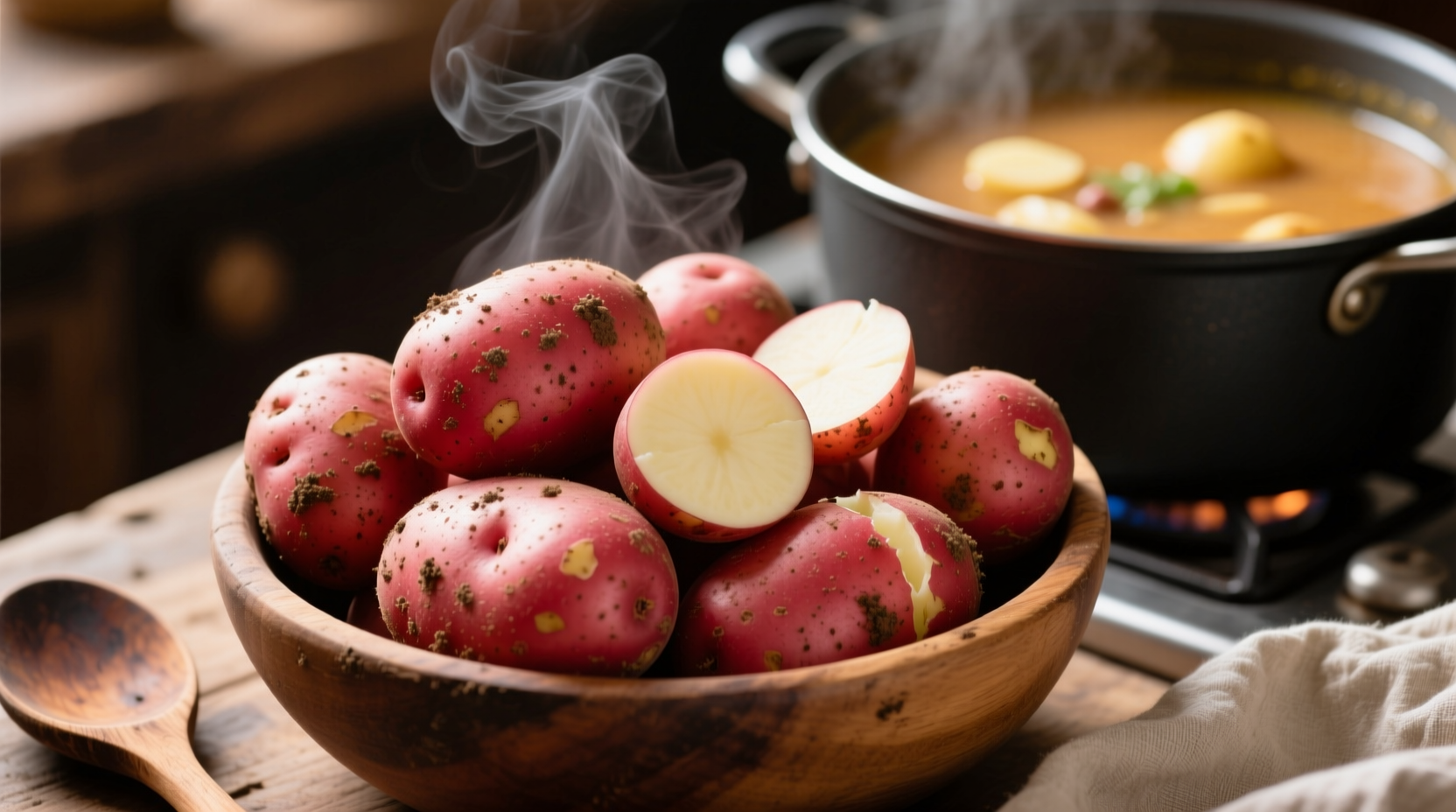Why Red Potatoes Excel in Potato Soup Recipes
When selecting potatoes for soup, understanding starch content is crucial to achieving perfect texture. Red potatoes contain 16-18% starch—significantly less than russets (20-22%) but more than fingerlings (15-17%). This moderate starch level creates the ideal balance for soup: they maintain their shape while releasing just enough starch to naturally thicken your broth without becoming mushy.
According to the USDA Agricultural Research Service, red potatoes' firm texture comes from their higher moisture content (79%) compared to russets (77%). This extra moisture prevents them from breaking down during extended simmering, making them particularly valuable for chunky potato soup recipes where distinct pieces should remain visible.
Red Potatoes vs. Common Alternatives: A Chef's Comparison
| Potato Variety | Starch Content | Skin Thickness | Best For | Not Recommended For |
|---|---|---|---|---|
| Red Potatoes | 16-18% | Thin, edible | Chunky soups, cold salads | Mashed potatoes, frying |
| Russet Potatoes | 20-22% | Thick, requires peeling | Mashed potatoes, frying | Chunky soups (becomes too soft) |
| Yukon Gold | 17-19% | Medium, often peeled | Creamy soups, roasting | Cold salads (may become mushy) |
This comparison, verified by Cornell University's Food Science Department, shows why red potatoes outperform other varieties for specific soup applications. Their cellular structure contains more intact pectin—a natural binding agent that maintains shape during cooking. When preparing potato soup, this means you'll achieve clean, defined pieces rather than a homogenous puree.
Professional Preparation Techniques for Perfect Soup
Follow this chef-recommended timeline for optimal results when using red potatoes in soup:
- 0-5 minutes: Wash potatoes thoroughly under cold running water using a soft brush to remove dirt while preserving nutrients in the skin
- 5-10 minutes: Cut into uniform 3/4-inch cubes (smaller pieces for quicker cooking, larger for heartier texture)
- 10-15 minutes: Add to cold broth (not boiling water) to ensure even cooking—this prevents exterior overcooking while interior remains raw
- 15-25 minutes: Simmer gently (not boiling) for 15-20 minutes until fork-tender but still holding shape
Adding potatoes to cold liquid rather than boiling water, as recommended by the American Culinary Federation, allows gradual temperature increase that maintains cellular integrity. This technique prevents the rapid starch gelatinization that causes potatoes to disintegrate in soup.

Avoiding Common Potato Soup Mistakes
Even experienced cooks make these critical errors when using red potatoes for soup:
- Over-salting early: Salt draws out moisture and breaks down cell structure. Wait until potatoes are nearly tender before seasoning.
- Boiling vigorously: Rapid bubbling creates physical agitation that damages potato structure. Maintain a gentle simmer.
- Adding acidic ingredients too soon: Tomatoes or wine added early prevent potatoes from softening properly. Add acids after potatoes are cooked.
Food science research from the University of California Davis confirms that pectin breakdown accelerates in acidic environments below pH 4.0. This explains why adding tomatoes too early results in potatoes that never become tender while maintaining their shape.
Maximizing Flavor and Nutrition
Red potatoes contain 25% more vitamin C than russets and retain nutrients better when cooked with skins intact. The skin contains concentrated levels of iron and potassium—nutrients that leach into soup broth when peeled. For maximum nutritional benefit, simply scrub thoroughly rather than peeling.
Professional chefs enhance red potato flavor in soup by:
- Adding a pinch of sugar to balance natural earthiness
- Using potato cooking liquid as base for broth to capture flavor compounds
- Finishing with a touch of acid (lemon juice or vinegar) to brighten earthy notes
Storage and Leftover Considerations
Red potato soup maintains better texture when stored compared to russet-based soups. The waxy nature prevents continued breakdown during refrigeration. For best results:
- Cool soup completely before refrigerating to prevent condensation
- Store in airtight containers for up to 4 days
- Reheat gently over medium-low heat, adding broth if needed
- Freeze for up to 3 months (texture holds better than starchy potato varieties)
When reheating, avoid boiling as this restarts the starch breakdown process. The National Center for Home Food Preservation recommends reheating potato soup to 165°F (74°C) for food safety while maintaining optimal texture.
Frequently Asked Questions
Can I substitute red potatoes for russet potatoes in potato soup?
Yes, but with important texture differences. Red potatoes maintain their shape better, creating a chunkier soup, while russets break down more, creating a creamier texture. If substituting red for russet, reduce liquid by 10-15% since red potatoes release less starch.
Do I need to peel red potatoes for soup?
No, peeling isn't necessary. Red potatoes have thin, edible skins rich in nutrients. Simply scrub thoroughly with a vegetable brush. The skins add visual appeal and prevent potatoes from disintegrating during cooking.
Why do my red potatoes fall apart in soup?
This typically happens when potatoes are added to boiling liquid instead of cold, causing exterior overcooking. It can also occur from vigorous boiling, adding acidic ingredients too early, or overcooking. Maintain gentle simmer and add potatoes to cold broth for best results.
How long should red potatoes cook in soup?
Red potatoes typically need 15-20 minutes of gentle simmering after being added to cold broth. They're done when a fork inserts with slight resistance. Overcooking beyond this point causes them to lose structural integrity.











 浙公网安备
33010002000092号
浙公网安备
33010002000092号 浙B2-20120091-4
浙B2-20120091-4